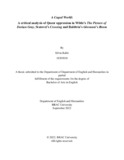| dc.contributor.advisor | Mohammad Noman, Dr. Abu Sayeed | |
| dc.contributor.author | Kabir, Silvia | |
| dc.date.accessioned | 2023-03-05T08:40:31Z | |
| dc.date.available | 2023-03-05T08:40:31Z | |
| dc.date.copyright | 2022 | |
| dc.date.issued | 2022-09 | |
| dc.identifier.other | 18303018 | |
| dc.identifier.uri | http://hdl.handle.net/10361/17940 | |
| dc.description | This thesis is submitted in partial fulfillment of the requirements for the degree of Bachelor of Arts in English, 2022. | en_US |
| dc.description | Cataloged from PDF version of thesis. | |
| dc.description | Includes bibliographical references (pages 43-44). | |
| dc.description.abstract | Whether it was acknowledged or not, homosexuality and same-sex interactions existed in every
society. In the past, homosexual individuals faced discrimination due to their gender identification
in Christian-based societies. In writing about homosexuality, early LGBT writers like Oscar Wilde
and James Baldwin experienced great suffering. Laws have been developed to secure society
against LGBT individuals. They are perceived as a hazard that has the potential to undermine
traditional society's moral standards. The Picture of Dorian Gray by Oscar Wilde made a
groundbreaking statement since it depicted gay characteristics in Victorian culture, where
homosexuals were referred to be demons. Wilde always tried to challenge the established social
structure and the bourgeois throughout his works. He became a victim for pursuing his personal
choices which were considered a sin in Victorian society. However, his sufferings made him a
pioneer figure in Gay liberation later on. Subsequently, the novel Giovanni’s Room by James
Baldwin was published during the mid of 19th century when homosexuality was considered a
mental illness in American society. Statovci’s Crossing comes at a time when many of us have
become sceptical of binary classifications, such as gay, heterosexual, woman, and man, and have
started to see how insufficient they are to capture the reality of human lives. This paper aims to
analyze Queer oppression in Wilde’s The Picture of Dorian Gray, Statovci’s Crossing and
Baldwin’s Giovanni’s Room by exploring Queer theory which challenges the established norms.
Also, the paper aims to analyze the domination of class differences towards queer people by
exploring Marxist theory. Lastly, the paper aims to acknowledge the battle of queer people to
understand their true selves by exploring the psychoanalytical approach. | en_US |
| dc.description.statementofresponsibility | Silvia Kabir | |
| dc.format.extent | 45 pages | |
| dc.language.iso | en | en_US |
| dc.publisher | Brac University | en_US |
| dc.rights | Brac University theses are protected by copyright. They may be viewed from this source for any purpose, but reproduction or distribution in any format is prohibited without written permission. | |
| dc.subject | Queer oppression | en_US |
| dc.subject | The Picture of Dorian Gray | en_US |
| dc.subject | Statovci’s Crossing | en_US |
| dc.subject | Baldwin’s Giovanni’s Room | en_US |
| dc.subject.lcsh | Queer theory in literature | |
| dc.title | A Caged World: A critical analysis of Queer oppression in Wilde’s The Picture of Dorian Gray, Statovci’s Crossing and Baldwin’s Giovanni’s Room | en_US |
| dc.type | Thesis | en_US |
| dc.contributor.department | Department of English and Humanities, Brac University | |
| dc.description.degree | B.A. in English | |

